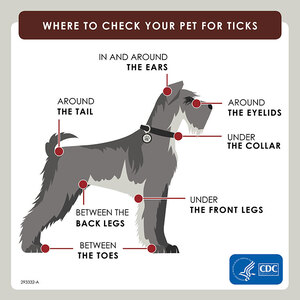Time to Take Flea and Tick Season Seriously
Flea bites can lead to excessive itching and scratching, and dogs with hypersensitivity to flea saliva may suffer from flea allergy dermatitis. The flea injects its saliva into the pet’s body while biting, causing histamine secretion and triggering an allergic reaction that can result in inflamed skin, irritation, hair loss, and scratching.
Ticks are small in size and can easily go unnoticed, but they pose a significant threat once they attach themselves to your dog. Ticks are capable of transmitting various diseases, such as:
Common Tick and Flea Diseases
Lyme Disease
Lyme disease can cause fever, loss of appetite, reduced energy, lameness, generalized stiffness, discomfort, or swelling of joints
The standard treatment for the infection typically involves a course of antibiotics that may last for at least 30 days. In most cases, this medication effectively resolves the symptoms, but in some instances, the infection may persist, requiring extended treatment. Additionally, other therapies aimed at alleviating specific symptoms can also be a part of the treatment.
Rocky Mountain Spotted Fever
Similar to the symptoms of lyme disease, RMSF also may cause poor appetite, muscle/joint/abdominal pain, vomiting, diarrhea, swelling of the face or legs, or fever. Dogs begin to show symptoms between 2 – 14 days after the bite occurs.
Antibiotics used to treat RMSF are tetracycline, doxycycline, and minocycline. Many dogs respond well to the antibiotic treatment and can show improvement in 24 to 48 hours after starting treatment.
Flea and Tick Prevention
Best Flea and Tick Prevention Methods
There are several effective methods for preventing ticks and fleas on your pets. Here are some of the best ways to protect your dog:
- Use tick and flea preventive medication: Your veterinarian can recommend or prescribe medications that kill or repel ticks and fleas. These medications can come in the form of topical treatments, pills, or collars. Some medications can also prevent other parasites such as heartworms.
- Keep your home and yard clean: Vacuuming and cleaning your home regularly can help reduce the risk of fleas and ticks. Mow your lawn regularly, clear any bushes or tall grass, and remove any standing water sources.
- Use tick and flea repellent sprays: You can use sprays that contain natural ingredients like essential oils to repel ticks and fleas from your pets.
- Check your pets regularly: Regularly check your pets for ticks and fleas, especially after they’ve been outside in wooded or grassy areas. Promptly remove any ticks you find.
- Keep your pets away from wild animals: Wild animals can carry fleas and ticks that can spread to your pets. Keep your pets away from areas where wild animals are known to frequent.
- Use flea combs: Flea combs can help remove fleas from your pets’ fur. Comb your pets regularly to remove fleas and keep their fur clean and healthy.
Check Your Dog for Flea and Ticks
- Place your dog on a white countertop, sheet, or piece of paper to easily spot fleas.
- For long-haired pets, use a comb to part the hair and examine the skin for fleas.
- Check for flea dirt, which appears as small specks like pepper, by running your fingers through the fur, especially in the neck and tail regions. Adding a drop of water to flea dirt will turn it into a dark brownish-red color due to digested blood.
- Flea bites can cause small, red irritated spots on the skin, commonly found in warmer areas of the body. Ticks are more visible and can be spotted easily.
- White dandruff that moves could be lice, not fleas or ticks.
- While itching can be a symptom of these pests, it can also indicate other conditions.
- Prevention is always the best way to keep pests at bay.

Image from CDC Page on Tick Prevention
It’s important to talk to your veterinarian about the best tick and flea prevention methods for your pets based on their individual needs and lifestyle.

